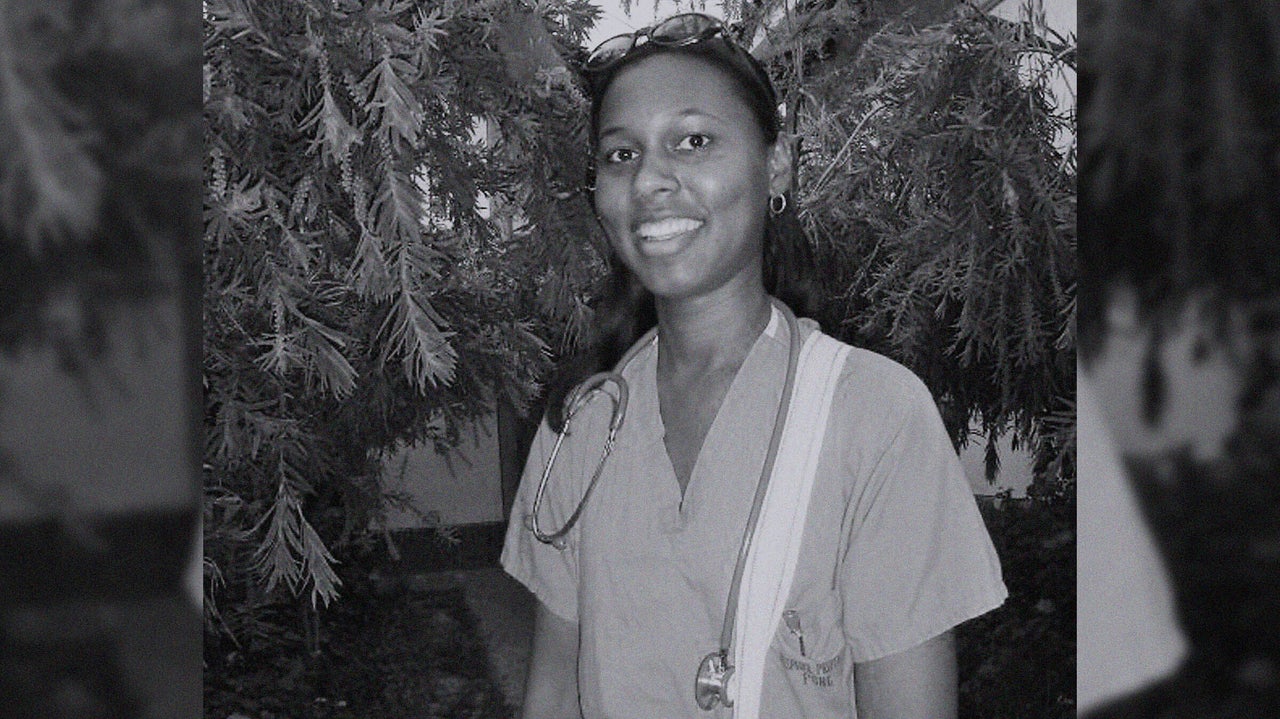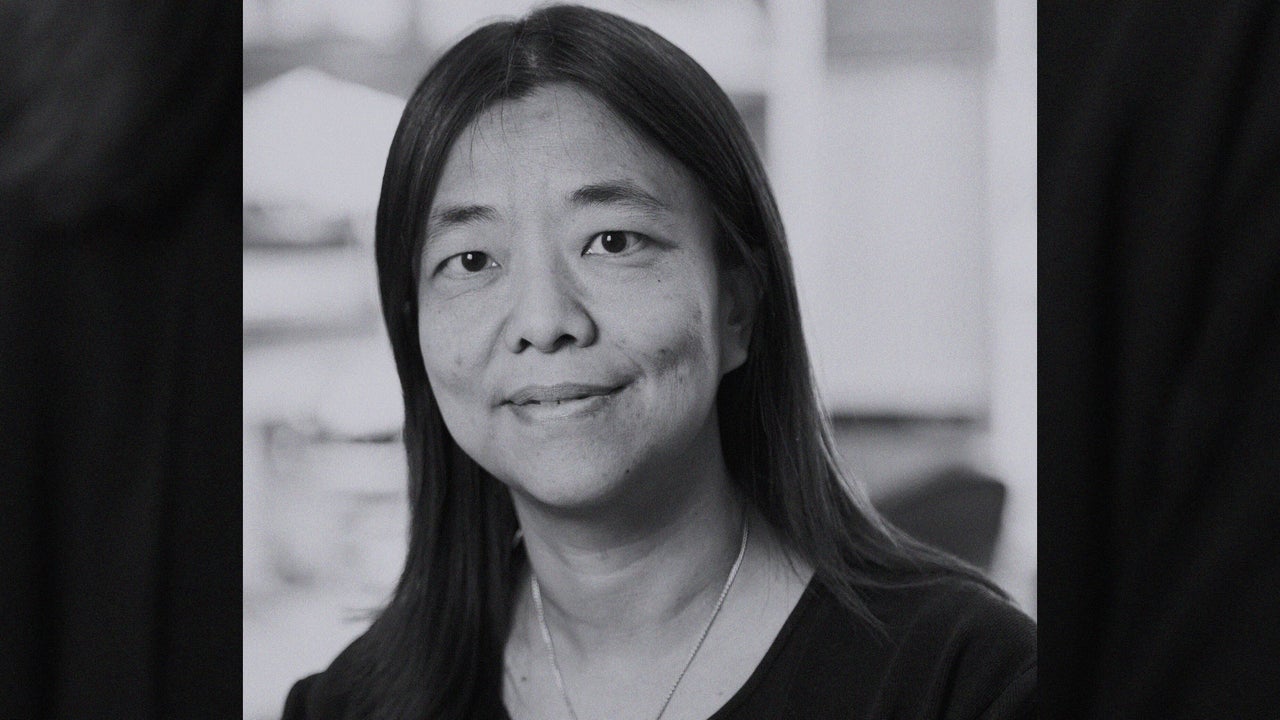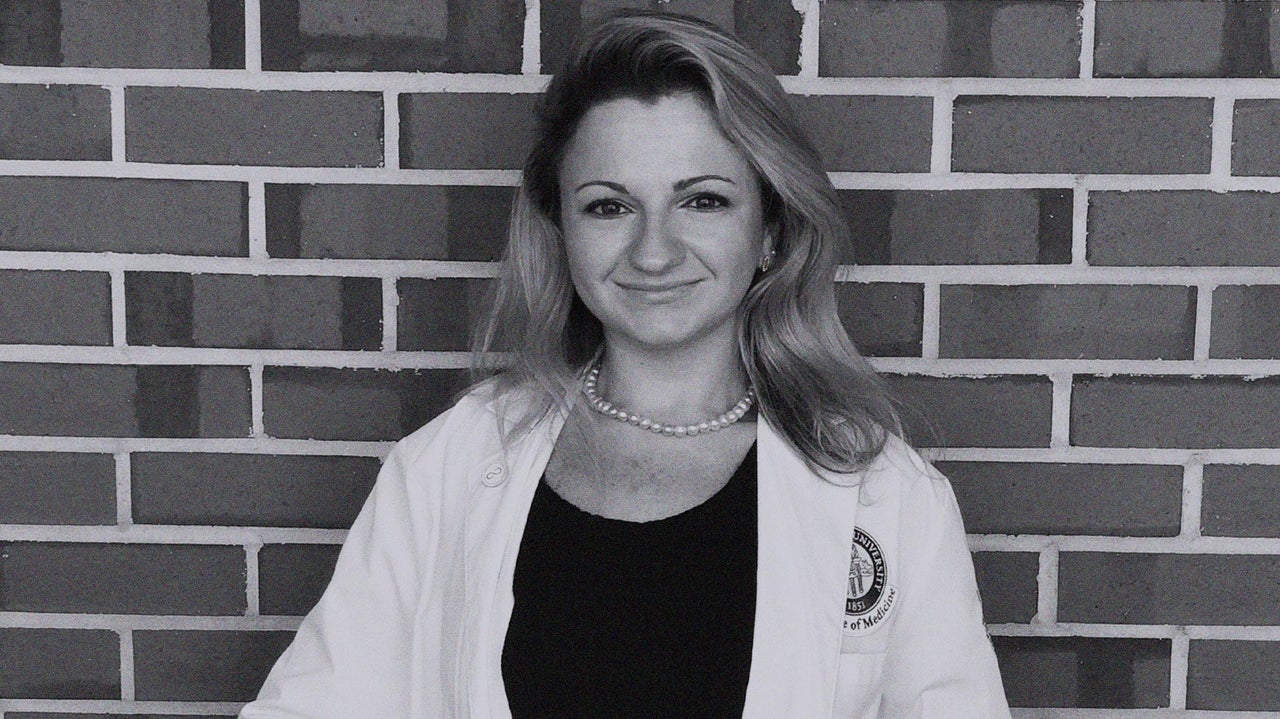Diana Cejas was working as a resident physician at a New Orleans hospital when doctors discovered a cancerous tumor on her neck.
The tumor had grown larger and more painful over time, eventually metastasizing to her lymph nodes. After Cejas had a successful surgery in July 2012 to remove the lymph nodes, she thought that was the end of it — but her troubles were far from over. Twelve hours later, she woke up in the intensive care unit on a ventilator. A stroke had paralyzed the left side of her body.
At the time, the then-30-year-old was training in pediatrics. Her workdays were grueling, with some shifts lasting as long as 28 hours. She was used to working up to 80 hours a week, a typical schedule for a pediatric resident. But after the stroke, she found herself taking speech therapy and occupational therapy, and figuring out how to navigate her changed body.
She was still dealing with mobility issues and post-stroke fatigue when she resumed her residency just a few short months later, fearing — as many disabled medical residents and students do — that she would fall behind in her program.
“I felt like me being out of work was inconveniencing the rest of my team. I felt really ashamed and bad about it, even though I’d just had a stroke,” said Cejas, who is now 39 and has chronic pain, permanent weakness and sensory loss in one of her hands as a result.
She tried to push through the pain at first but soon realized she needed disability accommodations. That’s when she noticed a change in the way some co-workers treated her.
When she asked for dictation software to help her with note-taking, which she often spent hours into the night catching up on, an administrator brushed her off and told her she just needed to work harder. She learned that some of her colleagues — even those who knew what she’d just gone through — were gossiping behind her back and assumed that she just wanted special treatment, even when she had to leave work to get follow-up scans and bloodwork.
Another time, a surgeon yelled at her in front of patients and other doctors because Cejas had sat down during rounds — meetings where medical teams discuss patient care — and “wasn’t speaking loudly enough for his liking,” she recalled. After she informed the surgeon that she’d just had a stroke, he looked “ashamed,” but the damage was done.
“I felt like me being out of work was inconveniencing the rest of my team. I felt really ashamed and bad about it, even though I’d just had a stroke.”
- Diana Cejas, a pediatric neurologist based in North Carolina
“It was embarrassing,” said Cejas, who now works as a pediatric neurologist at the Carolina Institute of Developmental Disabilities and as an assistant professor at the University of North Carolina’s School of Medicine. “[The way I was treated during residency] really colored the rest of my training and changed the course of what I had planned for my career.”
About 3% of physicians in the United States identify as having a disability, compared with a quarter of the country’s population, according to a March survey conducted using data from the Association of American Medical Colleges. The most commonly reported disabilities among physicians include chronic health conditions such as cancer, diabetes, cystic fibrosis and asthma, followed by mobility-related disabilities.
For decades, the medical field has largely shunned doctors with disabilities, who often face stigma, fear of workplace retaliation and sometimes loss of their jobs or medical licenses. Some disabled doctors switch specialties or leave clinical medicine altogether to move into academia, the business world or other industries. Disability discrimination exists in every professional field, but doctors say the ableism in medicine is heavily intertwined with “grind culture” that expects them to work around the clock. New doctors in particular feel like they have to push themselves to the brink to succeed, regardless of their own well-being.
“Medicine expects you as a doctor to be a superhuman,” Cejas said. “Residents and trainees would joke about the fact that ‘I haven’t eaten all day, haven’t peed all day,’ and talk about it as if it’s something we should be proud of. There’s just a really insidious way that we expect doctors to be able to behave, and disability isn’t compatible with that view at all.”

Many of these long-standing issues have recently bubbled up to the surface, in part due to the coronavirus pandemic, which has forced the medical field to contend with the pervasive ableism that has harmed health care workers and the people they take care of. In the last year and a half, health care workers were hailed as “superheroes” even as they were battling a public health crisis, both physically and mentally. Workplace accommodations suddenly became widely available despite the fact that disabled people have been pushing for them for years. Meanwhile, people with disabilities have been deprioritized for vaccines and health care treatments — a practice known as health care rationing.
Doctors with disabilities have felt a collective sense of urgency to push these issues to the forefront and use lessons of the pandemic as an opportunity to transform medicine. Their advocacy has led to incremental changes across medical schools, hospitals and influential organizations that set industrywide policies.
But for many physicians, this is just the beginning.
‘I Felt Like A Lab Rat’
Wallace Wilson, a physician who has worn a leg brace since childhood, remembers his surgery rotation as a painful period during medical school. The first time he scrubbed in for a procedure, a nurse screamed at him for about 10 minutes after he touched a table where surgical tools had been placed. Wilson said that when the scrub nurse had finished reprimanding him, the surgeon operating on the patient told him, “Get over here. I feel like you’re a bull in a china shop,” while nodding toward Wilson’s leg brace.
“He told me he wanted to see my hands at all times and made me stand at the patient’s ankles while he operated on the patient’s neck with the other medical student,” Wilson told HuffPost.
That experience, among many others, led to several years of therapy, and Wilson still has not emotionally recovered. He’s not working in clinical medicine anymore.
Wilson is one of more than a dozen disabled doctors and other health care workers who shared their experiences navigating the medical world with HuffPost. Many of them went into great detail about experiencing differential treatment, receiving verbal harassment from co-workers and being dismissed from their jobs after asking for accommodations.
Joanna Bisgrove, who is hard of hearing, recalled a psychologist in her family medicine program who was supposed to be teaching residents about behavioral health. Instead, he spent their one-on-one discussions analyzing her disability and “how my brain worked,” she said.
“I felt like a lab rat,” said Bisgrove, who is now a family physician in Chicago. “There was a power differential in that I didn’t know how to push back against a superior.”
In medicine, there’s tremendous pressure to strive for perfection, doctors told HuffPost, leaving little room for vulnerability and compassion for those with disabilities and chronic illnesses. For budding physicians, success depends on a lot of factors: workplace culture; geographic location; race, gender identity and socioeconomic status; and how empathetic your colleagues are.
“For a lot of physicians of color, and trainees and medical students, the bar is so high. We have to be perfect,” said Cejas, who is Black and Latina. “People already expect that you don’t know what you know, they expect you only got in for affirmative action. So you’re having to prove you can do the work, you’re intelligent, you know what you’re saying and doing.”

Vivian Cheung, a physician-scientist at the University of Michigan Medical School, said she often feels uncomfortable speaking up when she’s had a relapse of her genetic disease.
“Oftentimes it’s not what you can do, but what you look like,” said Cheung, a professor in the genetics and pediatrics departments at the medical school. “Being an Asian, being a woman and being someone with a disability, I really do have to work many times harder to satisfy the general professional demands.”
The level of support you receive also depends on who your supervisor is. Some residents are lucky enough to have an attending physician who is flexible and supportive, while other supervisors may worry about perceived liability risks.
“I would say it’s almost random who gets accommodated or supported and who gets rejected or expelled basically from the field. A lot of it has to do with who your boss is,” said Peter Poullos, a radiologist at Stanford Medicine and executive director of the Stanford Medicine Abilities Coalition.
But the medical field is gradually taking steps to destigmatize disabilities among doctors.
The American Medical Association, for example, adopted new guidelines in June that distinguish between physicians with disabilities and “impaired physicians” who can’t practice safely even with accommodations or treatments, rather than assuming disability equals impairment. (It’s worth noting that this can still create an unspoken hierarchy in which some disabilities are viewed as superior to others.) The new guidelines come from a report by the AMA’s Council on Ethical and Judicial Affairs, which effectively sets the ethics policies for all of medicine.
“While some conditions may render it impossible for a physician to provide care safely, with appropriate accommodations or treatment, many can responsibly continue to practice, or resume practice once those needs have been met,” the report says. “In carrying out their responsibilities to colleagues, patients, and the public, physicians should strive to employ a process that distinguishes conditions that are permanently incompatible with the safe practice of medicine from those who are not and respond accordingly.”
“It’s almost like a contest as to who can be the fastest, most efficient, smartest superhero doctor who can jump into the room and save the day. ... It wasn’t enough to be good. You had to be great.”
- Peter Poullos, radiologist and executive director of the Stanford Medicine Abilities Coalition
The guidance also encourages physicians to help eliminate stigma around illness and disability, develop “inclusive training standards that enable individuals with disabilities to enter the profession and have safe, successful careers,” and advocate for accommodations so disabled physicians can continue to provide care.
Bisgrove, a member of the AMA’s House of Delegates, said that the guidelines were a “big deal” for doctors with disabilities and that they resulted from a growing collective of delegates speaking out about the need for long-overdue change.
“Physicians with disabilities have been invisible for so long, and the new ethical guidelines finally let us be seen,” Bisgrove told HuffPost. “Medical ethics are central to the AMA’s processes and procedures, and so setting anti-ableism into the core of our policy and ethics makes it a foundation on which all other anti-ableism policy can exist.”
Lisa Meeks, a researcher at the University of Colorado School of Medicine who has been studying disability inclusion in medicine for more than a decade, said these resolutions “will take time to trickle through the system” but that it’s part of a broader effort to ensure all physicians are held to the same standards.
“Everyone, regardless of disability, must be able to perform the core competencies of a medical education or the essential functions of a residency or job. This includes doing all of these in a safe manner,” said Meeks, who co-created the digital campaign #DocsWithDisabilities around 2018. “All physicians should be treated the same, and those with disabilities should have appropriate and reasonable accommodations to do so.”
What Makes A Doctor?
Though the new AMA guidelines are significant, doctors say it’s just one step to breaking down the broad misconception that disability is synonymous with incompetence. That belief is cultivated in them long before they set foot in a hospital.
For the first two years of medical school at the University of Vermont, Emerson Wheeler navigated classes with multiple invisible disabilities. Wheeler, who uses they/them pronouns, was approved to take frequent breaks and get note-taking assistance, but not without some side-eye.
“I’ve had to tell preceptors about my accommodations, and I’ve had them say back to me, ‘Well, if you need this much help, maybe medicine isn’t right for you. Maybe you need to rethink medicine,’” said Wheeler, who has Ehlers-Danlos syndrome, postural orthostatic tachycardia syndrome and other disabilities.
Last year, they co-founded the Alliance of Disabilities and Chronic Illnesses in Medicine, a national advocacy group of more than 70 doctors and medical students fighting for a “more accessible future in medical education,” according to ADACIM’s website.
Several local and national groups like ADACIM have formed over the last few years to support disabled doctors and medical students. There’s also the Society for Physicians With Disabilities, which hosts monthly meetings and manages an email listserv for hundreds of disabled students and professionals to discuss topics such as interview tips, job advice and self-disclosure.
Disclosing one’s disability, especially a mental illness, is tricky for all of these reasons and can jeopardize a doctor’s ability to practice medicine.
Wheeler, who is also trans, said they regularly experience “decision fatigue” around when and who to disclose their identities to. In the last year, their disabilities have become increasingly visible, and they started using a cane around the time rotations began.
“I’ve had attendings or supervisors, when they meet me, just asking me, ‘What’s wrong with you?’ instead of saying hello,” Wheeler told HuffPost. “I’ve had people telling me I’m inspiring and they’ll keep me in their prayers, and I’m just in the elevator trying to get to work. I’ve been told I’m in the wrong room.”
These sorts of microaggressions build up over time and can create a culture in which disabled doctors feel like their qualifications as health care professionals are doubted.
“You don’t expect your doctor to be anything but fit and healthy and perfect because ‘practice what you preach,’ but many illnesses are really not preventable in a lot of ways, especially mine because it’s genetic,” Wheeler said.
The Untenable Grind Culture

Disability is also often left out of educational curriculums. Some medical schools — even ones that claim to prioritize diversity and inclusion — fail to incorporate disability training at all in their classes, even though it’s been shown to help reduce medical bias, according to a 2018 report from the Association of American Medical Colleges and the University of California, San Francisco, School of Medicine.
When Priscilla Morelli, who has osteogenesis imperfecta, started studying at Florida State University College of Medicine, she noticed there was very little instruction for medical students on how to interact with disabled patients. She could only recall a one-hour session in which her class invited a single disabled guest speaker to come talk about their life story.
“It provided a very surface-level ‘people with disabilities exist, and you need to be ready for that,’” said Morelli, who will start her second year of medical school in August. “And that’s pretty much what it was.” After connecting with several students at other medical schools, she realized this wasn’t an isolated issue at her school.
Morelli is now vice president of ADACIM, the national advocacy group co-founded by Wheeler. Morelli also launched the Disability Advocacy Series at her school, hosting monthly events that teach medical students best practices on caring for disabled patients, respectful language and disability discrimination in health care, among other topics — all the material she felt should’ve been a standardized part of medical education in the first place.
The lack of disability awareness in schools coupled with unrealistic expectations to be “superhuman” in clinical settings create a rat race that doctors say is untenable — for everyone. For those who finish medical school and postgraduate training, the belief is that if they managed to do it, everyone else should be expected to as well.
During Cejas’s neurology training program, there were several months when she was required to work a 14-hour shift for six consecutive nights.
“It’s impossible to live up to that standard, whether you are disabled or not,” she said. “I’m thinking about how one of my friends in residency who got a kidney stone because she was holding her urine for too long. That’s something that happens all the time.”

Before Poullos became paralyzed in a biking accident in 2003, he worked similarly brutal hours. As an intern, he worked 33- to 36-hour shifts every four days.
“It’s almost like a contest as to who can be the fastest, most efficient, smartest superhero doctor who can jump into the room and save the day,” said Poullos, who now uses forearm crutches. “It wasn’t enough to be good. You had to be great.”
Rethinking The World Of Medicine
This issue doesn’t just affect doctors. When health is viewed as a measure of someone’s worth, it hurts both workers and patients.
A survey from February found that more than 80% of physicians believe significantly disabled people have a lower quality of life than those who aren’t. It’s concerning given that disabled and chronically ill people make up a large number of patients seen by doctors — increasingly so during the pandemic.
COVID-19 is now the third-leading cause of short-term disability in the United States, and health care workers are among those who’ve acquired disabilities through so-called long COVID. Over the last year and a half, the coronavirus has shed light on the need for more disabled doctors who have an idea of what their patients go through — less “clinicalization” of disability and more humanity. What would hospitals look like if more disabled health care workers were on the other side of the examination table? What if there was less focus on fixing people — especially those whose disabilities have no cure — and more emphasis on recovery and management of conditions and making society easier for disabled people to live in?
“This has affected the entire system,” Cejas said of the pandemic. “You’ve got this huge increase in the disability population [due to long COVID], and part of those people coming in with those conditions, these newly disabled people, are health care workers who got the virus. We have to start looking at what it means to have a lot of disabled physicians or a lot of physicians with mental health conditions practicing all at once and trying to practice through this.”
Many patients feel like having a physician with a disability makes a big difference in the quality of their care.
“It’s just this ‘aha!’ moment and an extra connection that doesn’t need to be explained when you know your doctor sitting across from you says, ‘I understand,’” said Bonnie Woolston, 73, a Baltimore-based writer with amyotrophic lateral sclerosis Type 4. She’s been a patient of Cheung’s for about five years and said Cheung is the first doctor out of dozens she’s seen who has symptoms similar to hers.
“Because Dr. Cheung has a disability … and has difficulty walking and with stamina and balance, she understands how this affects my everyday life,” she told HuffPost.
Disclosing a disability and other personal details to patients isn’t generally encouraged among doctors, since it can be viewed as unprofessional, but Cejas said it can also help foster trust.
“It’s a personal choice, but I think every time I’ve done it, it’s done nothing but strengthen the relationship with that patient,” she said. “For my chronic pain patients, I end up disclosing to them more than anyone else, just so I can say, ‘I’m not going to be the doctor that’s not going to believe you. I know what it feels like to be in pain and for people to act like it’s not a big deal.’”
About a month ago, a little boy walked into the clinic where Cejas works. As Cejas examined him, she noticed the particular way her patient moved his hand. It mirrored her own.
“I could tell he was a little nervous and shy about his hand and how it moves, so I was like, ‘Hey, do you want to know a secret? I have the same thing. Look at me,’” Cejas said.
Cejas recalled that the boy was worried about what it would mean for him to have a disability for the rest of his life. No other doctor had told him that it was OK to be disabled or what his future could look like. Would he be happy and successful? What could he grow up to be?
She looked at her patient.
“I’m disabled, and I’m a doctor,” she told him. “Go do what you want.”
